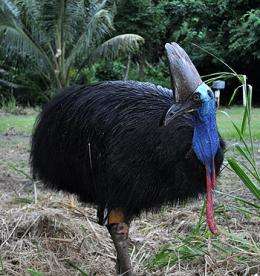A phone in the hand maps bird in the bush

(PhysOrg.com) -- Queenslanders are being encouraged to lend their iPhones to science, in a new initiative to uncover the behaviour of one of the states most elusive birds - the cassowary.
Queenslanders are being encouraged to lend their iPhones to science, in a new initiative to uncover the behaviour of one of the state's most elusive birds - the cassowary.
A collaborative project between the University of Queensland, Queensland Parks and Wildlife, Australian Geographic and Rainforest Rescue has launched a new website which hopes to encourage the public to help track local cassowary populations.
Members of the public can input the details of their cassowary sightings manually on the webpage, or if they have an iPhone or other GPS-enabled smart phone, can upload footage of the birds and record their position using Google Maps.
Head researcher Dr Hamish Campbell, from UQ's School of Integrative Biology, said the website will provide much needed scientific data on cassowary movement patterns.
“In recent times major changes in the cassowary habitat, due to human intervention, have resulted in a high mortality for cassowaries,” Dr Campbell said.
“The website will enable us to develop a large database on the populations and habits of cassowaries which frequent urban areas.
“Such information from the public will be vital to implement a conservation strategy and management recovery plan that will enable the protection of currently unprotected habitats, suitable for local cassowary populations.”
The launch of the website coincides with the satellite tagging of 10 cassowaries, captured around fragmented habitats and pristine rainforests.
The movement patterns of the tagged birds will be displayed on projected satellite images and maps on the website and a number of public talks have been organised to raise awareness throughout local communities.
Although the cassowary (Casuaris casuaris) is the only large-bodied seed disperser in the Australian rainforest spreading some 238 fruiting plants, very little is known about them.
Dr Campbell said the project would also help with understanding the ecology as well as behavioural characteristics of the species.
“Much of the present behavioural and population information collected on them is either speculative or based on incidental chance observations.
“The findings from our project will also elucidate the biological, behavioural and ecological requirements of the species, in particular, those activities relating to breeding, feeding and drinking.”
To find out about the project and record your cassowary sightings, visit the website at www.uq.edu.au/eco-lab/cassowary-research
Provided by University of Queensland


















